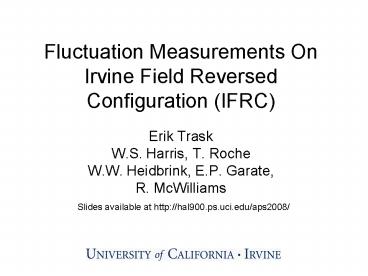Fluctuation Measurements On Irvine Field Reversed Configuration IFRC
1 / 22
Title:
Fluctuation Measurements On Irvine Field Reversed Configuration IFRC
Description:
1: Bare tip, high pass filter, amplifiers ... the case with RF pulses and bare tip. Once again, note the low amplitudes from 1-10 MHz for the filtered bare tip ... –
Number of Views:52
Avg rating:3.0/5.0
Title: Fluctuation Measurements On Irvine Field Reversed Configuration IFRC
1
Fluctuation Measurements On Irvine Field Reversed
Configuration (IFRC)
- Erik Trask
- W.S. Harris, T. Roche
- W.W. Heidbrink, E.P. Garate,
- R. McWilliams
Slides available at http//hal900.ps.uci.edu/aps20
08/
2
Poster Outline
- Magnetic field and plasma density descriptions
and measurements - Antenna description, probe design, and probe
calibration - Fluctuation measurement results from several
cases - Identification of fluctuations near
characteristic frequencies
3
Motivations
- Initial efforts were directed at measuring wave
propagation in the lower hybrid range of
frequencies - Large fluctuations were observed that obscured
the arrival time measurements of RF pulses - Further investigation has focused on descriptions
of the fluctuation characteristics
4
Fluctuations At Many Frequencies Are Observed
- Broad spectrum fluctuations have been observed on
the Irvine Field Reversed Configuration (IFRC) - Spectra range from 100kHz through 100MHz
- Fluctuations mostly correlate near the hydrogen
cyclotron frequency and the lower hybrid
frequency range
5
Diagnostics On IFRC
- Magnetic probe array
- 3D pickup loops measure Br, B?, Bz
- Radial spacing is 2.5 cm, axial spacing is done
by shifting the probes, with resolution of 5
cm. - Axial arrays measure Bz at an outer and inner
radius - Axial spacing is 2 cm
- Rogowski Coil measures induced plasma current
- Spectroscopy chord averaged
- Measures ion and electron temperatures
- Two color interferometer
- Langmuir/Mach probes
6
Derived Quantities From Magnetics
- We can measure, as functions of time and position
in an r-z plane, - 3D magnetic fields
- Flux surfaces
- Magnetic pressure
- Plasma pressure
- Various characteristic frequencies
7
Magnetic Field Profiles
8
Derivation of Plasma Density
- Three types of information are necessary to solve
the radial force balance equation. - Magnetic profiles, plasma temperature, and radial
fluid acceleration - Magnetic fields are known as functions of (r,z,t)
- Temperatures are known for a chord that passes
through the outer 2/3 of the plasma - The fluid velocity, which can be inferred from
the motion of the magnetic null
9
The Plasma is in Radial Force Balance
The plasma has three components, electrons,
protons, and carbon ions.
2
1
3
4
Equation 1 in the radial direction simplifies to
5
since the radial acceleration term, determined
experimentally, is very small compared to the
other two terms.
10
Density Estimations For Two Methods Give Similar
Results
- The top plot is derived from the force balance
equation, including curvature terms - The second plot is found by setting the RHS of
(5) equal to zero, with the density equal to 1010
cm-3 at Bmax
11
Probe Designs
- RF probe consists of semi-rigid coax, insulated
with a glass outer shield. - 1 Bare tip, high pass filter, amplifiers
- 20 MHz high pass filter is inline with signal
before amplification - 2 Capacitively coupled tip, amplifiers
- Tip is insulated, creating a high pass filter
with the 50 ohm termination of the amplifier
12
Recording And Analysis Methods
- RF probe data is digitized with a ZTEC PCI based
oscilloscope. It has a 200MHz sampling rate and
12 bit depth. - Higher frequencies have been checked with a
Tektronix scope, sampling at 500MHz, to ensure
fluctuation signals are not aliased. - Spectrograms are produced by wavelet transforms,
implemented in IDL software. - Spectrograms for each radial position measured
are averaged over at least 5 shots.
13
Antenna Design
- Antenna is a folded-terminated dipole
- Dominant fields created are Etheta and Bz
- Termination is 100 ohms at the center of the
dipole. - 30 MHz pulses at 20 duty cycle and period of 1-5
microseconds are transmitted to the antenna - Power to the antenna is 100 W
R Direction
Theta Direction
100 ohms
14
Fluctuations Are Measured For Several Different
Cases
- No RF pulses from antenna
- Bare Tip
- Capacitive Tip
- RF pulses at 5 microsecond rep rate
- Bare Tip
- Capacitive Tip
15
Raw Data
- Launched RF signal is picked up by the probe tip,
well above the noise background - Large spikes are due to switching noise on our
capacitor banks - The next step is wavelet analysis to find the
frequency components as functions of time
16
Fluctuations Are Near Characteristic Frequencies
- Data are from the case with no RF and
capacitively coupled tip - Fluctuations near fchyd and flh are present
17
Fluctuations 2
- Data are from the case with no RF and bare tip
- Frequencies below 10 MHz are not picked up as
well, due to high pass filter
18
Fluctuations 3
- Data are from the case with RF pulses and
capacitively coupled tip - RF pulse, bursts, and fluctuations near fchyd and
flh are present
19
Fluctuations 4
- Data are from the case with RF pulses and bare
tip - Once again, note the low amplitudes from 1-10 MHz
for the filtered bare tip
20
Bursts and/or Chirps
- Bursts Fluctuations sometimes occur over a wide
frequency band at the same time. - Frequency range is 1MHz to 20MHz
- Chirps Also observed are fluctuations changing
frequencies in time. - Frequency range is 50MHz
- See Videos!
21
Results Of Measurements
- Density profiles - reconstructed
- Fluctuations - measured
- Wideband
- Spatial structure follows inferred characteristic
frequencies - Chirps and bursts - sources are unknown
22
Future Work
- Measure fluctuations at different axial
positions. - Only one axial position has been measured at this
time - Investigate source of bursts and chirps
- Near large gradients in the magnetic field and
density?































